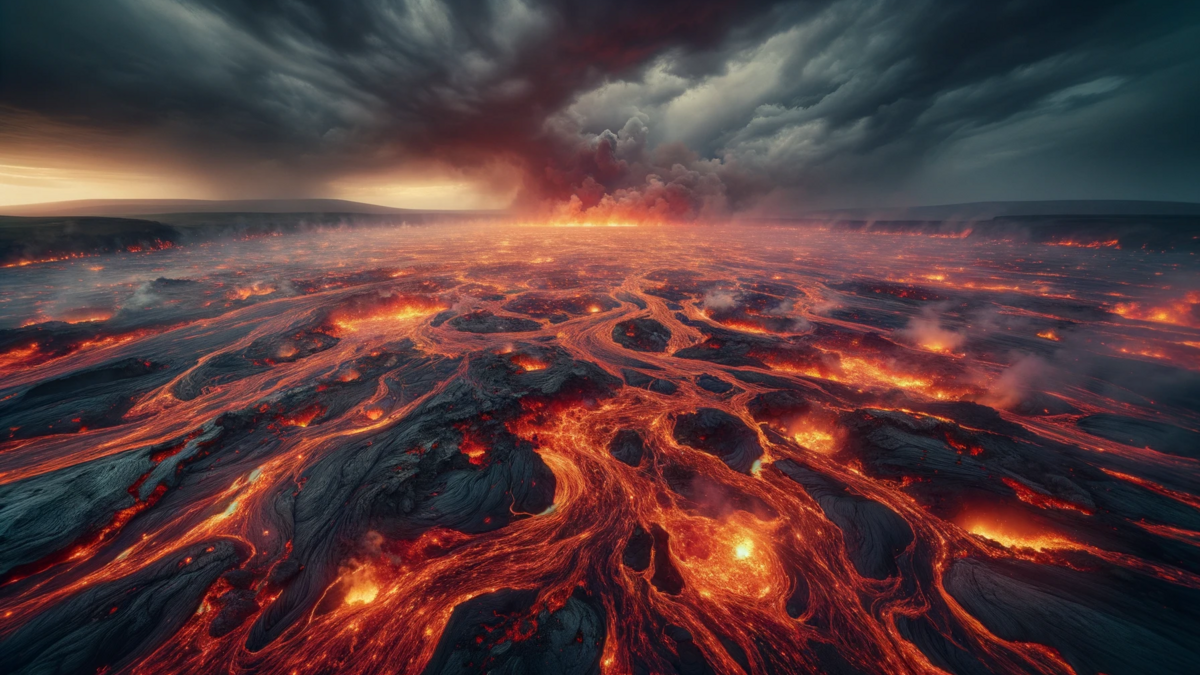Unraveling the mysterious chemistry of common exoplanets

Illustration of a magma ocean covered with a thick atmosphere of hydrogen on a sub-Neptune exoplanet. Also depicted are rising plumes of H2O vapor from the reaction between atmospheric hydrogen and silicate magma. Image courtesy Dan Shim/ASU
Since the early days of exoplaneta planet outside our solar system discoveries, astronomers have continued to reveal the properties of exoplanets with the help of the Hubble Space Telescope and now the James Webb Space Telescope. Recent astrophysical surveys show that exoplanets ranging in size between Earth and Neptune are abundant in our galaxy.
Among these, the larger ones, known as sub-Neptunes, are significantly less dense than their rocky counterparts. These sub-Neptunes, absent in our solar system, present a limited understanding. Models have attributed their low density to thick hydrogen atmospheres overlying molten rocky cores, presuming no interaction between hydrogen and magma.
In a new study published in the journal Proceedings of the National Academy of Sciences, a team of researchers from Arizona State University, the Eyring Materials Center at ASU and the University of Chicago hypothesized an upper-size limit for sub-Neptunes, potentially due to ingassing of hydrogen driven by the high pressures in more giant exoplanets of this type.
"Most of the studies did not consider a crucial process, which is the chemical reaction between ingassed hydrogen and the molten rocky cores (i.e., magma). Hydrogen is a highly reactive material; thus, hydrogen physically ingassed into the magma can have chemical reactions in the interior of sub-Neptunes," said Taehyun Kim, postdoctoral research scholar at ASU’s School of Earth and Space Exploration. "There are not many data on the chemical reaction because it has been very challenging.”
Sub-Neptunes are typically 1.8 to three times larger than Earth and rarely exceed this size range — this phenomenon still needs to be fully understood.
Kim and co-authors Dan Shim of ASU and Vitali Prakapenka and Stella Chariton of the University of Chicago conducted pulsed heating experiments at the Advanced Photon Source at Argonne National Lab to outmaneuver the mobile, hot hydrogen molecules.
Understanding these high-pressure processes necessitates heating silicate to a molten state together with hydrogen. However, the highly mobile and diffusive nature of hot, dense hydrogen poses a unique challenge, as it can damage the high-pressure device components, like diamond anvils, during experiments.
Further challenges arose from the fragile nature of the silicate samples that reacted with hydrogen. In collaboration with Shize Yang at Yale University, previously of ASU's Eyring Material Center, the team successfully prepared these delicate samples for high-resolution electron microscopy, which is crucial for uncovering unexpected chemical reactions between hydrogen and magma under high pressures.
Discoveries of unique chemical reactions
Shim's team unveiled that interactions between thick, hydrogen-rich atmospheres and sub-Neptune interiors can trigger unique chemical reactions. These reactions form hydrides, refuting the prior belief that sub-Neptunes' mineralogy mirrors that of rocky planets. Magnesium iron hydride forms at lower pressures, a compound explored for eco-friendly hydrogen storage, suggesting nature's capability to generate such materials. At higher pressures, magnesium hydride forms, dissolving into hydrogen.
This study opens new avenues in understanding sub-Neptune exoplanets. More massive planets initially attract more hydrogen from stellar nebulas. However, when this accretion forms a dense atmosphere, the resulting high pressures at the base of the atmosphere may lead to magnesium in magma reacting with atmospheric hydrogen. This ingassing of hydrogen into the planetary interior, rather than contributing to atmospheric buildup, could limit further planetary growth, elucidating the scarcity of larger sub-Neptunes.
Kim's experiments also revealed water formation, a critical component for habitability, from the reaction of hydrogen with magma. This finding gains significance in light of studies suggesting the transformation of some sub-Neptunes into super-Earths, potentially rendering the water formed during the sub-Neptune phase crucial for the habitability of these super-Earths.
Future endeavors and promising predictions
The study posits intriguing predictions, testable by astrophysicists using space telescopes like the James Webb Space Telescope (JWST) and large, ground-based telescopes like the Giant Magellan Telescope (GMT). One such prediction is the coexistence of water and hydrogen in sub-Neptune atmospheres due to these chemical reactions, with the potential for magnesium hydride, if elevated to higher atmospheric altitudes, to be detectable through spectroscopy. Shim's team plans to extend their experimental efforts to create essential chemical datasets for interpreting such astrophysical measurements.
"A significant proportion of these exoplanets likely exhibit chemical processes previously unobserved in Earth's systems or those of other solar system planets,” Shim said. “Consequently, laboratory experiments are crucial for interpreting the spectroscopic data from these distant exoplanets and for contextualizing these observations in terms of planetary evolution and dynamics."
More Science and technology

Study reveals genetic insight into desert survival
The deserts of the American Southwest are home to the Mojave and Sonoran desert tortoises, two seemingly similar yet genetically distinct species of turtles. These tortoises, adapted to different…

Study reveals lasting effects of common weed killer on brain health
Environmental exposure to toxins in the air, water or certain chemicals can increase the risk of ill health effects, including to the human brain.The human brain is an incredibly adaptable organ,…

ASU grad to use science to get an edge on crime
Editor’s note: This story is part of a series of profiles of notable fall 2024 graduates.As a child growing up in Pinetop, Arizona, Giavanna Caruth's family experienced a tragic loss in the early…